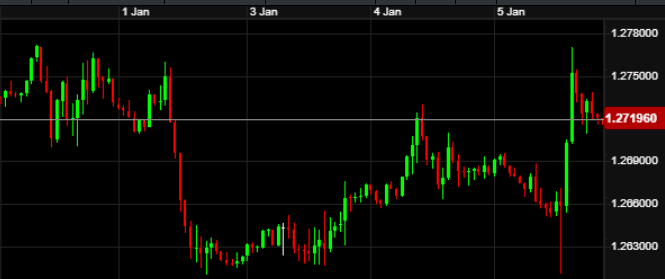ACM Update 08-01-24

A slower start to the new year thus far, with US jobs data taking most of the spotlight on Friday afternoon. Employment figures remain buoyant as the economy heads towards the desired soft landing. No need for the Federal Reserve to change policy stance yet, seemingly.
This week we hear from Andrew Bailey as he appears in front of the Treasury Select Committee, as well as the latest US CPI inflation figures. Both have the potential to drive GBP-USD, due to their impact on future monetary policy.
A slow start to 2024 for fundamental UK data last week. The only two real data releases were Services and Manufacturing PMI figures. The former managed to beat expectations at 53.4, whereas the latter was in line but still sub-50.
Many news headlines were centred around Rishi Sunak declaring an election won’t take place in the first half of the year. This will hopefully give the Conservatives a chance to get the UK economy out of recession, if indeed it is already in one. More data to follow on that this week in the form of November’s GDP figures.
There are mounting concerns in the UK that one of the wettest Decembers on record is going to have had a detrimental impact on high street spending pre-Christmas. Footfall was down 5% in the final five weeks of 2023 when compared to the same period in 2022, according to the British Retail Consortium.
Also vocal was the UK Institute of Directors, calling for the Bank of England to cut interest rates soon to support the sluggish economy. Their Confidence Index measuring optimism for the next 12 months, slumped in December to its lowest level since August. This seems unsurprising given the weak growth and sticky inflation.
The property sector had slightly better news though. Halifax HPI figures suggested average house prices grew by 1.1% over the last month. That came alongside the December mortgage approvals figure recording the highest in six months. Much of this renewed confidence though will be dependent on interest rates, and thus mortgage rates, falling throughout the coming year.
Moves for GBP during the week versus the Euro can be seen in the chart below:

US news was more prominent, with the latest Federal Reserve meeting minutes released on Wednesday evening (UK time). The December meeting showed officials see rate cuts likely, but there is uncertainty as to when. The majority of members acknowledged that they were “probably at the peak rate” as things stand. The overriding opinion was that the current restrictive stance would remain for “some time”. Read into that what you will. Their next meeting is on 31st January for more clues.
Aside from that, pretty much everything else from the US was jobs market related. Wednesday afternoon’s JOLTS job market data came in a long way short of expectation. This records the number of job vacancies currently available in the US.
The November numbers were revised back up slightly, though still demonstrating a continued downward trend in the number of job openings going back to September’s data. That said, the number of Weekly Unemployment Claims fell to its lowest since mid-October. A mixed picture.
Non-Farm Payrolls for December came in well above expectation once more, with 216,000 jobs added to the US economy in the month, versus a forecast 168,000. This meant a total of 2.7m new jobs created in 2023, “more than any year of the Trump administration” according to US President, Joe Biden.
The subsequent unemployment rate release remained at 3.7% for the second month. The buoyant jobs market is, for now at least, keeping pressure off the Fed to cut. The Dollar rallied back early in the week to eradicate some of its Christmas week losses, but the buoyant Non-Farm Payrolls figures of Friday afternoon reversed all of the weekly swing.
The above mentioned moves can be seen in this chart:

In the Eurozone, the biggest release was the latest headline CPI figure, which showed inflation bouncing back from 2.4% to 2.9%. Analysts had expected a jump back to 3.0%, based on pricing from the energy market. Energy prices were down 6.7% year on year in December, compared to an 11.5% drop in November.
Core inflation (which doesn’t include energy, amongst other factors) continued to fall from 3.6% to 3.4% though. The expected move back up in inflation is unlikely to change the mindset of the ECB, but will place more importance on the January CPI release, published in early February.
Other releases were Services and Manufacturing PMI data. Services numbers were up across all major EU states, but still sub-50 (expansion) for the bloc as a whole. Manufacturing numbers came in in as forecast, again all sub-50.
The week ahead:
Monday – Swiss inflation (07:30 UK time), EU Retail Sales exp -0.3% (10:00)
Tuesday – Australian Retail Sales (00:30), EU Unemployment Rate exp 6.5% (10:00)
Wednesday – Australian CPI inflation (00:30), Andrew Bailey speech (14:15)
Thursday – US CPI inflation exp 3.2% (13:30)
Friday – UK GDP m/m exp 0.2% (07:00), US PPI inflation (13:30)
Week two of 2024 doesn’t deliver masses of data quite yet. Seemingly a lot of economists and central bankers are enjoying an extended January break, or off on a ski trip….. Those releases we do have though, are of significance with plenty of potential for movement.
The EU employment market will be in focus on Tuesday morning. The unemployment rate remains an important indicator of the overall health of the economy and will continue to be a factor in whether the ECB need to look at cutting interest rates sooner rather than later. As mentioned last week, we currently expect Christine Lagarde & Co to begin their interest rate cuts in their March meeting.
The Bank of England Governor, Andrew Bailey, will be appearing in front of the Treasury Select Committee on Wednesday afternoon. He will be discussing the findings of the recent Financial Stability Report with the panel. Whilst not a policy decision meeting, he will be questioned on the Bank’s current and ongoing policy stance, so any comments surrounding holding/cutting/hiking rates will be important. Another UK indicator, the GDP change from October to November, lands on Friday morning.
The main release of the week will be US inflation numbers on Thursday lunchtime. These have somewhat stagnated over the last few months, with economist predicting a slight pick up to 3.2% for December, up from 3.1% in November. Again, any big deviations either way could be instrumental to what the Federal Reserve do with monetary policy at the end of January.
All in all, for GBP sellers buying EUR and USD, we still find ourselves in a favourable position towards the top of recent ranges. As a reminder, anyone converting GBP to USD is currently paying a full 5% less for their purchases than two months ago. A significant move and worth making the most of.
Markets can be an unpredictable beast, especially as we get to a stage where significant monetary policy changes will take place over the coming months. If you don’t want these moves to impact your purchases, please do reach out to the team and we can discuss the different approaches available to protect your costs.
You can simply reply to this email and a member of the team will be in touch.
Have a great week.